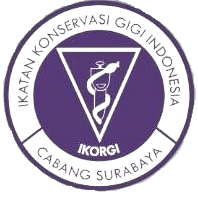Viability Test of Photodynamic Therapy with Diode Laser Waves Length 405 nm on BHK-21 Fibroblast Cells with Various Irradiation Distances
Downloads
Background: Photodynamic therapy has now become popular, but its cytotoxic effect is still unclear. In order to be considered suitable for oral cavity therapy, the therapy must not be toxic or cause adverse effects on the target tissue. Viability testing for photodynamic therapy is important to do. Fibroblast cells are often used for testing the toxicity of dentistry because they are the most important cells in the components of the pulp, periodontal ligament, and gingiva. Purpose: To prove the effect of irradiation distance on photodynamic therapy on the viability of BHK-21 fibroblast cells. Method: Viability test was performed with BHK-21 fibroblast cells placed on a 96 well microplate which was then irradiated with 405 nm photodynamic therapy with varying irradiation distances of 1, 4, 7, 10, 13, and 16 mm. After irradiation, cell viability was tested by MTT assay and ELISA Reader. Data were analyzed using Kolmogorov-Smirnov, Levene's test, Kruskall Wallis, and Tukey HSD. Result: Fibroblast cells with 4 mm irradiation distance have viability over control cells, whereas at irradiation distances 1, 7, 10, 13, and 16 mm have less viability than control cells. Conclusion: Photodynamic therapy 405 nm with 4 mm irradiation distance gives a biostimulation response so that the viability of BHK-21 fibroblast cells increases.
Tennert, C. et al. Effect of photodynamic therapy (PDT) on Enterococcus faecalis biofilm in experimental primary and secondary endodontic infections. BMC Oral Health14, 1–8 (2014).
Rhodes, J. S. Advanced Endodontis Clinical Retreatmant and Surgery. Development134, (Tylor & Francis, 2007).
Saxena, D., Saha, S. G., Saha, M. K., Dubey, S. & Khatri, M. An in vitro evaluation of antimicrobial activity of five herbal extracts and comparison of their activity with 2.5% sodium hypochlorite against Enterococcus faecalis. Indian J Dent Res26, 524–527 (2015).
Wright, P. P. & Walsh, L. J. Optimizing Antimicrobial Agents in Endodontics. Antibact. Agents (2017). doi:10.5772/67711
de Oliveira, B. P., Aguiar, C. M. & Cí¢mara, A. C. Photodynamic therapy in combating the causative microorganisms from endodontic infections. Eur. J. Dent.8, 424–430 (2014).
Maria Regina Lorenzetti Simionato, E. B. de S. Effect of Photodynamic Therapy with Different Formulations of Methylene Blue in Teeth Contaminated by Enterococcus faecalis. J. Phys. Chem. Biophys.03, 3–5 (2013).
Afkhami, F., Akbari, S. & Chiniforush, N. Entrococcus faecalis Elimination in Root Canals Using Silver Nanoparticles, Photodynamic Therapy, Diode Laser, or Laser-activated Nanoparticles: An In Vitro Study. J. Endod.43, 279–282 (2017).
Chiniforush, N., Pourhajibagher, M., Shahabi, S. & Bahador, A. Clinical approach of high technology techniques for control and elimination of endodontic microbiota. J. Lasers Med. Sci.6, 139–150 (2015).
Seguchi, K. et al. Critical parameters in the cytotoxicity of photodynamic therapy using a pulsed laser. Lasers Med. Sci.17, 265–271 (2002).
Trindade, A. C. & Steier, L. Photodynamic Therapy in Endodontics: A Literature Review. (2015). doi:10.1089/pho.2014.3776
Astuti, S. D., Zaidan, A. & Setiawati, E. M. Chlorophyll Mediated Photodynamic Inactivation of Blue Laser on Streptococcus Mutans. 120001, (2016).
Masson-Meyers, D. S., Bumah, V. V., Biener, G., Raicu, V. & Enwemeka, C. S. The relative antimicrobial effect of blue 405 nm LED and blue 405 nm laser on methicillin-resistant Staphylococcus aureus in vitro. Lasers Med. Sci.30, 2265–2271 (2015).
Kumar, A. et al. Antibacterial efficacy of 405, 460 and 520 nm light emitting diodes on Lactobacillus plantarum, Staphylococcus aureus and Vibrio parahaemolyticus. J. Appl. Microbiol.120, 49–56 (2016).
Ariani, M. D., Yuliati, A. & Adiarto, T. Toxicity testing of chitosan from tiger prawn shell waste on cell culture. Dent. J. (Majalah Kedokt. Gigi)42, 15–20 (2009).
Farivar, S., Malekshahabi, T. & Shiari, R. Biological Effects of Low Level Laser Therapy. J. Lasers Med. Sci.5, 58–62 (2014).
Calderhead, R. G. & Vasily, D. B. Low Level Light Therapy with Light-Emitting Diodes for the Aging Face. Clin. Plast. Surg.43, 541–550 (2016).
Suresh, S., Sivasankari, Merugu, S. & Mithradas, N. Low-level laser therapy: A biostimulation therapy in periodontics. SRM J. Res. Dent. Sci.6, 53 (2015).
Fresney, R. Culture of animal cells: A manual of basic technique and specialized applications. 183, (Jhon wiley and sons inc, 2016).
Huang, Y., Sharma, S. K., Carroll, J. & Hamblin, M. R. Biphasic dose response in low level light therapy – an update. Int. Dose-Respone Soc.9, 602–618 (2011).
Szymczyszyn, A., Doroszko, A. & Szahidewicz-krupska, E. Effect of the transdermal low-level laser therapy on endothelial function. 1301–1307 (2016). doi:10.1007/s10103-016-1971-2
Saygun, I., Karacay, S. & Serdar, M. Effects of laser irradiation on the release of basic fibroblast growth factor ( bFGF ), insulin like growth factor-1 ( IGF-1 ), and receptor of IGF-1 ( IGFBP3 ) from gingival fibroblasts. 1, 211–215 (2008).
Tjandrawinata, R. R. et al. Radikal Bebas dan Peran Antioksidan dalam Mencegah Penuaan. Medicinus24, 5 (2011).

CDJ by Unair is licensed under a Creative Commons Attribution 4.0 International License.
1. The journal allows the author to hold the copyright of the article without restrictions.
2. The journal allows the author(s) to retain publishing rights without restrictions










